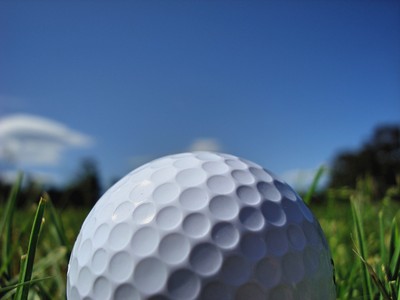 To outsiders, golf can seem a complex sport, one that is often assumed to be a game for the middle classes and one in which knowing the rules and etiquette is crucial. There is of course some truth in that but at its heart golf is a simple game that involves getting the small white ball from the tee and into the small distant hole in as few shots as possible. As Rory McIlroy’s Twitter bio says, “I hit a little white ball around a field sometimes”.
To outsiders, golf can seem a complex sport, one that is often assumed to be a game for the middle classes and one in which knowing the rules and etiquette is crucial. There is of course some truth in that but at its heart golf is a simple game that involves getting the small white ball from the tee and into the small distant hole in as few shots as possible. As Rory McIlroy’s Twitter bio says, “I hit a little white ball around a field sometimes”.
That said, in the same way that cricket has a number of different formats, chiefly T20 games, 50-over matches and Tests (to name just a few), the sport of golf can be played in a range of ways. The game itself remains the same but the scoring and nature of how the participants compete against each other changes. The two main “formats” are stroke play and match play, though you also have others such as Stableford (a form of stroke play) and Skins (a form of match play). In this piece we will explain the key differences between stroke play and match play, as well as taking a brief look at the biggest events in the different forms of the sport.
The Difference Between Stroke Play and Match Play
Stroke play golf is where the number of strokes a player takes to complete an 18-hole course are added together to give an overall score. In professional golf tournaments this is usually repeated over four days of play to give a 72-hole score.
Match play golf is where two or more players compete against each other to have the lowest score at a particular hole. Whoever has the better score wins a point. Where two players or teams take the same number shots at a particular hole, the points are shared or halved. Again these are accumulated over 18-holes though if a player of team has an insurmountable lead, all 18 holes do not need to be played.
Stroke Play Versus Match Play

The vast majority of professional tournaments on all tours, be it the seniors, men or women, or the PGA, European or Sunshine Tours, are contested using the stroke play format. In one sense, that is one of the biggest differences between the two: stroke play is used far more frequently. In order to show the differences, we will first explain the fundamentals of the mechanics of both.
Stroke Play Golf
Stroke play, which is sometimes also called medal play, is very simple and when most people think of golf, it is this that probably comes to mind. The key point is that the winner is the player who takes the fewest strokes in total. This is the same underlying principle whether it is two friends playing 18 holes together on a Saturday morning to decide who pays for lunch, or whether we are talking about 156 of the world’s greatest golfers teeing it up at St Andrews over 72 holes in the Open Championship.
No matter how many players are taking part and no matter how many holes or rounds the tournament or event is scheduled for, the player with the lowest aggregate score for all holes is the winner. And that is really that.
Match Play Golf
In match play golf two players, or four players in teams of two, play each holes together and for that round or those rounds they are playing only against each other. The winner is not decided by who has the lowest overall score but instead by who wins the most holes. Typically match play takes place over just 18 holes and the match is effectively broken down into 18 mini-contests.
Whichever player scores the lowest on each hole is awarded that hole, such that if Rory McIlroy scores a four on the first and his opponent, Dustin Johnson, scores a five, Rory is said to be “one up”. If they both make a three on the second the hole is “halved” and so the Northern Irish ace retains his lead. If he then finds water on the third and contrives to shoot an eight, whilst DJ makes a birdie four, the score goes back to level. After three holes Rory has taken 15 shots, three more than Johnson, yet because of the match play format the players are level.
If after 18 holes the players remain level, they are either awarded half a point each, usually in team formats like the Ryder Cup, or some tournaments that may have a round-robin phase; alternatively, they enter a sudden-death play-off, where the first player to win a hole claims the match.
Major Differences Between Stroke Play And Match Play Golf

Aside from the fact that stroke play is by far the more commonly used method of scoring, there are a number of other key differences between match play and stroke play. Some are strategic, whilst others are practical or logistical.
- In Stroke Play Every Shot Matters
- Match Play Can Be More Aggressive
- Play The Golfer Not The Course
- Tactics And Gamesmanship
- Scoring System
- Not All The Holes Are Played
- If It’s A Team, It’s A Match
- Knockout Format
- Will You Make The Cut?
- Multiple Rounds In A Day
- Play-Offs, Count Back And Halves
- How The Handicap Is Applied
In Stroke Play Every Shot Matters
Because stroke play uses the total score for a round or more, every shot really matters. One terrible error can cost a player heavily. For example, if a golfer finds the water multiple times and scores a 12 on the very first hole of a typical four-round competition, their entire tournament is all-but over. They have lost seven, eight or perhaps even nine shots to par and getting back into contention is virtually impossible. In contrast, when it comes to match play, such an error can only cost a player the hole.
This is a rather extreme example but illustrates that consistency is far more important in stroke play than match play. In match play, two or three bad shots here and there may cause limited damage whilst in stroke play they could well prove decisive. On the other side of the coin, an eagle or an albatross is essentially as good as a bogey in match play if they all result in a hole being won.
Match Play Can Be More Aggressive
Related to this is the fact that in match play golfers can be more aggressive as they know that the worst-case scenario is the loss of just a single hole. It isn’t necessarily the case but generally players who can make a lot of birdies and eagles, even if they come with a fair smattering of bogeys and doubles, will prosper at match play. In contrast, steady Eddies making par after par may find they beat their opponent on aggregate but lose the match.
Play The Golfer Not The Course
Following on from this last point, quite how aggressive or otherwise a player can, or should be, in match play depends very much on the situation in the game. In match play, a golfer’s sole focus is their opponent, whilst for most of the time in stroke play all that matters is the course and the score. In stroke play a par four is always a par four but in match play a four may either be enough to win the hole, or result in one losing it.
Elements of match play sometimes come into things at the very close of a stroke play tournament. For example, the four players in the final two groups may be very close in terms of score, such that if one makes a birdie, the others know they must do the same to stay in the hunt. Or if a score has been set in the clubhouse, the few players left out on the course know what score they have to beat and can adjust their play accordingly.
In contrast, with match play, this is the permanent state of affairs. If the first player hits their ball in the trees, the second can switch from a driver to a three wood. If one player misses their putt, the other knows they have two to win the hole, so can simply roll up rather than needing to be aggressive.
Tactics And Gamesmanship
In some ways this is the same point but when it comes to match play, playing the golfer not the course means there is often far more strategy, tactics and gamesmanship. Once again, there are elements of this in stroke play too, for example when a golfer decides that scoring is hard and they must be patient. They may decide that level par is a good score on a given day and tweak their approach accordingly. Alternatively, in the closing stretch of a tournament, they have a better idea of exactly what they need to do.
However, in match play things go to the next level and all sorts of tactics can legitimately be used. Golf has a reputation as a game of gentlemen but in match play gamesmanship can become a grey area. There are many tactics a golfer can use, with some of the most common ones being to slow things down if they know their opponent likes to play quickly.
Another well-known tactic is to concede a few early putts when they don’t much matter. In match play, as the game is head-to-head, players do not need to hole out short putts if the opponent concedes them (another difference between the formats). By conceding early on, the hope is that a player does not get to find their groove with the pressure off and so when made to hole a short one later on, with more riding on it, they may miss.
Another tactic that players may use is to deliberately hit their drive a little shorter than their opponent. This gives them the chance to play their approach first, the theory being that if they then hit it close they can apply some pressure to their rival’s next shot.
Scoring System
We have already briefly touched upon the scoring systems used in the different forms of this sport. In stroke play, it is the aggregate total for all the holes played. As such, a winning score might be 280 for a standard event played over four rounds on a par 72 course. You may well see this same score expressed in relation to par, so the winner may be said to have won with a score of -8, or eight under par.
In contrast the winner of a match is based on the score in holes and is expressed in relation to how many holes they won by, and by how many holes were left. If Player A is one up with one to play, they are said to be “dormie one” (dormie is the term used to describe the situation where the worst a player can do is tie the match). If they win the 18th hole they win “two up”, if they halve it, they win “one up”, whilst if they lose it, the match is either halved or goes to a play-off.
If a player starts very strongly and manages to make it to dormie six, anything other than a loss on the 13th hole will mean they win. If they halve the 13th they will be six holes ahead with only five left to play. Such a margin of victory is described as “six and five”, meaning the player is six holes up with five left to play. The biggest possible win in an 18-hole match play event is 10 and eight, where one player wins all 10 of the opening holes.
Not All The Holes Are Played
Because of the scoring system detailed above and the head to head nature of match play, players will not necessarily complete all 18 holes. Once a player has an insurmountable lead the game ends, so in our extreme case above, the players would return to the clubhouse after just 10 holes. There is no way the losing player can achieve even a tie and so the match ends at that point.
In contrast, in stroke play tournaments every player must complete all scheduled holes and rounds. This is primarily because they are competing against the entire field rather than just one opponent. As such, their overall score is relevant even if they cannot win and is used to determine their own and other players’ finishing position.
If It’s A Team, It’s A Match
Whilst there are some individual tournaments that feature match play, the vast majority of events on all of the tours are stroke play. However, when it comes to team events, these are almost always match play.
Iconic contests like the Ryder Cup use a mix of singles and pairs matches, the latter being played in both fourballs and foursomes. All, however, are played as match play contests, with this format being seen as the best way to create a tense, exciting competition.
Knockout Format
Another major difference is that in stroke play, you are effectively playing all the other golfers at the same time. Whoever shoots the lowest score wins and that is that. However, in match play you face one opponent at a time, meaning that most match play events, certainly individual rather than team ones, feature a number of rounds, for example, the last 64, last 32 and so on through to the semi-finals and a final.
These “rounds” are more like those in a football tournament than the normal four rounds we speak of in golf. As such, match play events have a very different structure and feel. Whilst some may now use a round robin format prior to a knockout phase (again, like football, rugby and other similar sports), they still feel like higher pressure situations because one bad round can see a player exit the tournament.
Will You Make The Cut?
Whilst making it out of a match play events “group phase” can be viewed as making the cut, it isn’t really the same. Match play tournaments, by their nature, do not have a cut, whilst almost all stroke play events do. Obviously this means that certain betting markets are not available in match play – “to make the cut” being the obvious one – but others too, including ones such as “first round leader”.
Multiple Rounds In A Day
In stroke play events it is rare for golfers, certainly at the professional level, to play more than 18 holes in a day. The main time this might happen is where the weather has interrupted play the previous day. However, in match play golf it is far more normal, with it not uncommon for a golfer to play a match in the morning and another in the afternoon.
The knockout structure of most match play tournaments, the fact that players go head to head rather than compete at once against the entire field, means this is often necessary for logistical reasons. This may mean that younger or fitter players are at an advantage in match play golf so could be something to consider with your golf bets, especially in hot and humid conditions.
Play-Offs, Count Back And Halves
In some sports, chiefly football, draws are commonplace but when it comes to golf, more often than not some form of method of splitting players who finish level is used. In both stroke play and match play, a play-off is often used, meaning the golfers who cannot be separated (for the tournament title in stroke play and in an individual game in match play) compete over extra holes to determine who wins.
In stroke play though there is an alternative means available, although this is only really used in club (amateur) golf these days. Count back entails looking at a player’s last 18 holes (in multi-round tournaments), last nine holes, last six, last three, or last one hole to separate players who finish level. So if two players tie an event with a score of 74 but one shot 36 on the last nine and the other shot 34, the player who scored 34 inbound wins. If both shot the same then the last six holes only are considered and so on.
Lastly, in match play, especially in team events, matches may sometimes be “halved”, meaning that there is no winner. Such an outcome is virtually unheard of in stroke play but in events such as the Ryder Cup a reasonable proportion of individual matches will be a tie, with the honours shared.
How The Handicap Is Applied
Obviously this does not apply to professional events but in amateur golf, the handicap system applies differently to stroke and match play. In the former, all participants knock the total of their handicap off their total gross score. In contrast, in match play, the handicaps of the two players are used to calculate how many shots the weaker player will be awarded. Different methods are used to do this but if we assume that the higher-handicapped player receives four shots, these will be taken on the four hardest holes on the course (in line with the Stroke Index).
Biggest Events In Match Play Golf
![]() As we have said, the vast majority of pro events are stroke play, so we will not spend too long detailing the biggest stroke play contests. In short, all four majors, the Open, the Masters, the US Open and the USPGA Championship are stroke play tournaments. The unofficial “fifth major”, the Players Championship, is also stroke play, as are the season-ending events that make up the FedEx Cup Playoffs on the US Tour. In addition, three of the four World Golf Championships (WGC) events, tournaments that sit just below the majors and have similar prize money and high-quality fields, also use stroke play.
As we have said, the vast majority of pro events are stroke play, so we will not spend too long detailing the biggest stroke play contests. In short, all four majors, the Open, the Masters, the US Open and the USPGA Championship are stroke play tournaments. The unofficial “fifth major”, the Players Championship, is also stroke play, as are the season-ending events that make up the FedEx Cup Playoffs on the US Tour. In addition, three of the four World Golf Championships (WGC) events, tournaments that sit just below the majors and have similar prize money and high-quality fields, also use stroke play.
So, what about match play? Well, as we have implied, one of the four WGC events is a match play contest. The aptly named WGC Match Play was first played in 1999 and has had a number of different names over the years due to varying sponsorship deals. Tiger Woods has been the dominant golfer when it comes to the WGC tournaments and his three wins (2008, 2004 and 2003) put him ahead of Australian pair Jason Day and Geoff Ogilvy (who both have two wins).
This is the biggest non-team match play event in the sport and as well as the players listed, the likes of Rory, DJ, Luke Donald, Bubba Watson and Henrik Stenson have all won it during its short history. In 2021 Billy Horschel took home a cheque for over $1.8m when he won, with total prize money that year of some $10.5m.
Ryder Cup

The WGC Match Play may be the prestigious match play singles event but there is no doubt that overall the biggest match play golfing contest on the calendar (every other year in any case) is the Ryder Cup. First played in 1927, since 1979 it has been a contest between the USA and Europe. The format has been tweaked over the years but for some time we have seen 12 players from each side do battle over three days of brilliant match play golf. If you want to know what match play golf is all about, check out the Ryder Cup, with no other tournament able to match it for excitement, tension, competitive edge and rivalry.
There is a range of other similar team events that have a very similar structure to the Ryder Cup and also use match play as their basis. The Walker Cup, for amateurs, pre-dates the Ryder Cup by five years, whilst the Solheim Cup was founded in 1990 and is essentially the women’s equivalent of the Ryder Cup. The Presidents Cup sees the US play an international team whilst over the years a number of other contests have come and gone.
Gone But Not Forgotten
Way before the WGC Match Play existed there was a brilliant event called the World Match Play Championship. First played in 1964 this sadly ceased to exist in 2015 but the list of past winners shows what an incredible tournament it was. Due to the small fields (for most of its history no more than 16 players competed) repeat winners were common and the list below shows the most successful players.
- Ernie Els – 7 wins
- Seve Ballesteros and Gary Player – 5 wins
- Greg Norman and Ian Woosnam – 3 wins
- Nick Faldo, Arnold Palmer and Hale Irwin – 2 wins
Played at Wentworth for almost half a century, the World Match Play was also won by Lee Westwood, Colin Montgomerie, Vijay Singh, Sandy Lyle, Jack Nicklaus and Bob Charles. For many years this was categorically the match play event and for many, especially in Europe, it is sadly missed.
